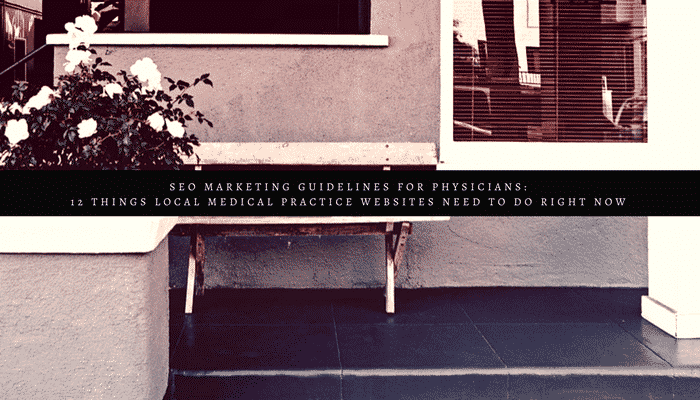12 Things Local Medical Practice Websites Need to Do Right Now
Incorporating search engine optimization or SEO guidelines into your medical practice will increase your visibility for new patients. However, implementing medical marketing seo ideas can seem overwhelming if you are not familiar with the concept.
When it comes to marketing your medical clinic location or personal medical practice website, your goal is to be easily visible in search results. To achieve this, it is imperative that you optimize your website and your marketing strategy, specifically keeping your patient’s convenience at the core of your marketing strategy.
Does Your Medical Office Have a Convenient Online Presence?
Unbelievably, a majority of patients these days look for a doctor online. And this recent change in the ‘search’ trend has reduced the need for traditional means of advertising. If you want to be successful, it’s time you adapt to the changes in patient behavior.
The second important thing to note here is that optimizing your medical practice website content provides your visitors more convenience. When it comes to optimized websites, the navigation systems act like a roadmap to the different areas of information within the different pages.
What experience do you want the visitor to have? The answer to this question will shape your SEO strategy.

What is SEO After All?
Some of you might be eager to know what exactly is search engine optimization or Medical Marketing SEO. Well, SEO is a strategic approach to making your website more visible in search engines. A number of factors influence search engine rankings, including the quality of your content, link building and of course, the duration your website has been active.
Therefore, no matter if you have an old website or you are trying to build a medical practice website from scratch, following are 12 guidelines you need to follow to make the most of your website presence.
Website Optimization Isn’t a Complete Shot in the Dark
As a medical practitioner or medical office manager, you have the expertise at your disposal. Moreover, all you need to do is position your expertise online in the right places where your audience needs you.
There are 5 key points you need to remember before creating any SEO strategy for medical practice.
Determine Your Biggest Strength
You must have a specialty and the greatest way to translate on-site success into Medical Marketing SEO results is to use the website to highlight your best practices.
Remember that choosing a limited set of medical procedures initially can help you direct customer attention. What’s better is that focusing on your strengths can make keyword research much easier.

Technical vs. Attention Grabbing Content
If you want your medical practice website to be successful, you need to know your audience. More importantly, you should know how people are searching for the problem you solve (keyword research) and what do they want to know (about doctors, procedures and/or medical facility).
The key ingredient that determines a website’s success is the use of quality content. Patients come to your website looking for details related to medical procedures and you have to present this information in a simple yet engaging manner.
Perhaps the trickiest task medical practitioners’ face is turning technical content into information that is easily understandable. For example, if you are a plastic surgeon, you have a wealth of knowledge about the technicalities of breast augmentation or tummy tuck procedures. However, your real task is to connect with your audience and separate your clinic or practice from others.
Get Listed on Google Local
Although it’s up for debate, most patients give priority to Google search. And there’s no better way to get to the Google’s first page and reach patients in your area than Google Local. Remember, you can convince more patients to come in if you are just around the corner.

Focus on User Experience
You’re more likely to achieve a higher ranking and get more online traffic if your practice’s website establishes a connection with the visitor. A variety of outstanding tools, like Google Analytics or Clicky, can help you track where visitors are coming from. They help tell you how they are using your website and most importantly, how you can improve their visit experience.
Keywords Are Important, but They Are Not Everything
Keywords have always been the main focus when it comes to SEO and there have been countless debates over the right length of keywords and the number of keywords you need to have on your website.
Well, the rules in 2017 are slightly different. While keywords are still important, they are just the tip of the iceberg when it comes to SEO best practices your website really needs.
How can you make your medical practice or facility stand out? Here are the marketing guideline practices to follow.
On-Page Search Engine Optimization
#1: Unique Title Tags
Title tags, as the name suggests, specify the title of your webpage. So, take advantage of your brand and write for your customers.
Remember that:
- The title tag will be your visitor’s first interaction with your website and it needs to display the most accurate message possible. These tags are displayed on search engine result pages as clickable links.
- The title tag you choose should be an accurate and more importantly, concise description of your page’s content.
- Ideally, your title tag should be under 60 characters. If the title too long, search engines might cut it off.
- You should avoid generic titles. After all, ask yourself how likely you are to click on a webpage titled About Us, or one without any title.
For example, if you are a dentist in Orlando and have a specific patient education page, you’ll want to make sure the page features the keyword “dentists” as well as “finding dentists in Orlando”.

#2: Pay Attention to Clean URLs
Relevant, compelling and accurate URLs can help your website rank high in search engines. URLs for your medical clinic website should:
- Use hyphens to separate words when necessary. This enhances readability.
- Don’t exceed 2,048 characters
- Be as descriptive and at the same time, as brief as possible
- Have keywords for higher search engine rankings
- Match with title tag (only if it makes sense)
- Keep a close eye on case sensitivity
- Last, but most importantly, limit redirections to two jumps or even fewer
#3: Duplicating Content is a Poor Etiquette
Duplicate content becomes a problem when search engines index more than one version of your webpage. Simply put, it’s difficult for Google to decide what page to display in response to a search query.
The biggest causes of duplicate content include:
- Additional URL parameters
- Printer friendly pages
- Session IDs
Google Webmaster Tools can help you identify duplicate content problems for your website.
The easiest ways to fix duplicate content are:
- Canonical Tags – These tags allow you to tell search engines what version of the webpage you want to use for specific search queries.
- 301 Redirects
- Meta Tags – They work best because you can tell search engines not to index a particular page
#4: Images and Logos
Our brains process visually attractive information much faster than plain, boring text. This is the reason why you should include your logo and other relevant visuals as an integral part of search optimization tools for medical offices to help out your visitors.
To improve your medical office website ranking:
- Optimize ALT tags, i.e. describe the image and use relevant keywords
- Show multiple product angles (if applicable)
- Reduce the file size of your image to increase page load speed. Remember, if your attractive images keep loading for 20 seconds, you can wave that prospective visitor goodbye!
#5: Remain Consistent with WWW. Or Non-WWW
The www vs. non-www debate has long been part of SEO marketing for physicians. Most folks prefer writing www. for reaching a website (in fact, it’s kind of a reflex) and this is why you should consider adding them.
If you are using a non www URL, enable the 301 redirect to enable patients to reach the intended page. Remember, whatever option you choose (www) or non www, you have to remain consistent.
#6: Use Webmaster Tools to Communicate with Google
GWT or Google Webmaster Tools is the primary source of communication between Google and verified webmasters. The best thing is that GWT is a free tool provided by Google and it helps you understand what’s going on with your website.
Configuring your clinic’s website with GWT does a better job. After all, Google isn’t familiar with your website the way you do.
You can use Google webmaster tools to provide:
-
Site Map
Once you submit a sitemap, Google will identify what pages you have and what pages to index. If you fail to submit a sitemap, Google will not index a majority of the pages on your website.
-
Crawler Access
There are pages on your website that you don’t want Google to index. Creating a robots.txt file helps you mark pages and content as no-follow. Saving the crawler time to focus more on relevant content.
-
Site Links
Site links are inside pages of the website displayed on a search results page.
-
You Can Tell GWT If You Want To Change the URL of Your Website
Google webmaster tools also allow you to set a preferred domain or target patients for your website.
#7: Get Google Analytics Working for You
To make the most of Google Analytics:
- Use a tag manager to implement Google Analytics code
- Make sure you have GA code on every page
- Be consistent with naming conventions
- Maintain one ‘unfiltered’ view of your Google Analytics profile
- Enable ad reporting features as well as demographics and interest reports
- Link your GA profile to AdWords
- Link Google Analytics to Google Search console
- Set up goals and conversion funnel tracking
#8: Optimize Your Navigation Menu
The design of your website navigation is critical. Not only does it affect visitor’s experience, but also it has a significant impact on your online traffic and search engine rankings.
- Patients expect to find your navigation menu right across the top or located vertically. Putting navigation menu in a standard place would lead to more pages visit and a lower bounce rate.
- You should avoid using generic labels, such as services
- Dropdown menus aren’t the best choice. Patients might skip important pages this way
- Never place too many items on your navigation menu. No more than 7 is good.
- Priority pages should appear first followed by less important pages
- You should always have clickable links in the navigation menu
#9: Google My Business Page is Essential for Local Search Results
- First things first, fill out your business information as the more information you add, the better Google’s algorithms will work in terms of ranking.
- Claim your listing and ensure that your details are accurate
- Check your phone number(s) and working hours. You can use AdWords to drive more traffic during the peak hours
- Check the business images you are using
- Analyze your efforts with Google Analytics or Google Insights
#10: Use Local Landing Pages to Attract More Patients to Your Medical Clinic
- Identify where your customers are based. Your Google business page should have a dedicated street address and a local phone number to attract more visitors
- Use city, area in your title tags, meta descriptions and keywords
- More than 60% search queries come from mobile devices, so optimize your website for mobile users.
To maximize new patient generation, design separate local pages for each city you are targeting and create a relevant Google+ Local Page.
#11: Use Your Website Blog to Help Your Potential Patients
Even the best website blogs can go unnoticed if there’s no proper SEO in place. Once you have great content, the next step is to optimize your blog with SEO in mind. Optimize to the
- Make sure your blog page title is something catchy. It’s OK to think about keywords
- Write a creative 160–character Meta description. You should mention what your blog is about and why it matters. Again, keywords come in handy here.
- Use H1 tag once to let visitors know what your blog page is about
- Add creative images along with ALT tags
- There must be categories to help visitors navigate your blog. Even search engines find it particularly effective.
- Last, there should be internal linking to other important pages of your website.
#12: Have a Mobile Responsive Medical Website
Most visitors now use mobile devices for browsing and you have to optimize your website for different screen sizes.
To avoid turning mobile visitors away,
- Improve page loading speed
- Don’t block images, CSS or JavaScript
- Don’t use Flash or pop-ups
- Optimize page titles and meta descriptions
- Optimize website pages for local search
- Ensure that you have a responsive website design
What marketing tactics will you use to improve visibility of your local medical office locally? Share your ideas in the comments.








